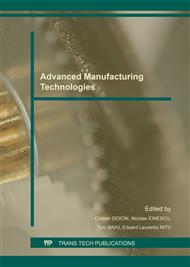[1]
T. Vopát, J. Peterka, M. Kováč, I. Buranský, The Wear Measurement Process of Ball Nose end Mill in the Copy Milling Operations, Procedia Eng. 69 (2014) 1038-1047.
DOI: 10.1016/j.proeng.2014.03.088
Google Scholar
[2]
T. Xianhua, Z. Jun, Effect of cutting speed on cutting forces and wear mechanisms in high-speed face milling of Inconel 718 with Sialon ceramic tools, Int. J. Adv. Manuf. Tech. 69 (2013) 2669-2678.
DOI: 10.1007/s00170-013-5206-4
Google Scholar
[3]
C.E.H. Ventura, A. Hassui, Evaluation of static cutting forces and tool wear in HSM process applied to pocket milling, Int. J. Adv. Manuf. Tech. 65 (2013) 1681-1689.
DOI: 10.1007/s00170-012-4290-1
Google Scholar
[4]
C. Xiaoxiao, Z. Jun, H. Shiguo, Effects of inclination angles on geometrical features of machined surface in five-axis milling, Int. J. Adv. Manuf. Tech. 65 (2013) 1721-1733.
DOI: 10.1007/s00170-012-4293-y
Google Scholar
[5]
Z. Song, L. Jian-feng, Tool wear criterion, tool life, and surface roughness during high speed steel end milling Ti-6Al-4V, J. Zhejiang Univ. Sci. A. 8 (2010) 587-595.
DOI: 10.1631/jzus.a0900776
Google Scholar
[6]
K.A. Kadirgamaa, A. Abou-el-hosseinb, Tool life and wear mechanism when machining Hastelloy C-22HS, Elsevier Wear. 270 (2011) 258–268.
DOI: 10.1016/j.wear.2010.10.067
Google Scholar
[7]
Q. Xinyi, L. Pengnan, Study on serrated chip formation and tool wear of cerment tools for milling stainless steel 3Cr13Cu. Int. J. Adv. Manuf. Tech. 77 (2014) 461-467.
DOI: 10.1007/s00170-014-6476-1
Google Scholar
[8]
M.B. da Silva, V.T.G. Naves, Analysis of wear of cemented carbide cutting tools during milling operation of gray iron and compacted graphite iron, Wear, 271 (2011) 2426-2432.
DOI: 10.1016/j.wear.2010.11.030
Google Scholar
[9]
P. Pokorný, J. Peterka, Š. Václav, The task of 5-axis milling. TEH. VJESN. 19 (2012) 147-150.
Google Scholar
[10]
Peterka, J. Analysis of the geometry and kinematics of copy milling. In: Vedecké práce (Science Theses) MTF STU in Trnava, 5 (1997) 53- 58.
Google Scholar
[11]
C.C. Tai, K.H. Fhu, A predictive force model in ball-end milling including eccentricity effects, Int. J. Mach. Tools Manufact. 34 (1994) 959–979.
DOI: 10.1016/0890-6955(94)90028-0
Google Scholar


